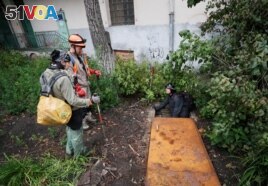10 October 2021
Diggers in Lviv, Ukraine, have uncovered new underground hiding places where Jews fled from Nazi German forces during World War II.
Under Lviv's stone streets are the sewers where some Jews hid. Historians say the Nazis killed 100,000 Jews in Lviv at that time. That was about one-third of the city's population.
A few were able to survive, including father and daughter Ignacy and Krystyna Chiger. They escaped from the Jewish ghetto by digging an underground passageway to the city's sewers. They later wrote books about their experiences.
Historian Hanna Tychka and local diggers said they recently found the exact area where Chiger's family lived in 1943 to 1944, using the books as a guide.
Chiger dug a seven-meter-long tunnel to the sewer from his ghetto bedroom. He had to break a solid wall, which was 90 centimeters thick, Tychka said.
"They had to work quietly so that Nazis would not find out that digging activity was happening in the barrack(s) basement. The Jews used a hammer wrapped in a duster," Tychka told Reuters.
In September and October Ukraine is marking the 80th anniversary of the shooting of nearly 34,000 Jews. The shooting happened at Babyn Yar in the capital of Kyiv. It is one of the biggest killings of Jews during the Holocaust, the genocide against the Jews during World War II.
In Lyiv, Tychka and her team discovered in July a small underground area. They believe it is where Jews fleeing the ghetto would stay their first night before moving to a larger shelter in the sewers.
In the larger shelter, the team found objects they believe the hiding families used. They found an old plate, a toy sheep and pieces of light. They also discovered pieces of glass placed in between bricks in the wall, which were used to prevent rats from stealing food.

Diggers Andriy Ryshtun and Oleksandr Ivanov and historian Hanna Tychka prepare to go underground to explore the city sewage system. REUTERS/Gleb Garanich
During a visit to the site, Tychka also pointed out a pipe from where she believed the families could take drinking water.
Chiger's family was part of a larger group that also included Halina Wind Preston, then in her early twenties.
Of the group of 21, only 10 including the Chigers and Halina survived, said her son David Lee Preston.
A baby was born to one of the women in the group. The baby was suffocated for fear that its crying would give away the group's hiding place, Preston said.
Preston worked as a reporter for many years in Philadelphia. He has written several reports about his mother and his father's experience as a prisoner in the Auschwitz and Buchenwald death camps.
He said many could not accept the conditions inside the sewer and left. They were always in danger of being discovered. Preston has written that two sewer workers helped his mother and her group during the time they lived in the hiding place.
They left their hiding place when the Soviet army took Lviv back from the Nazis in July 1944.
Preston was thankful to Tychka and the team who made the discovery. He said that, as the number of Holocaust survivors decrease, it is important for younger generations to tell their stories.
The work to find the group's hiding place showed "a great desire by many young Ukrainians to set straight the history and prevent it from being corrupted," Preston said.
I'm Dan Novak.
Sergiy Karazy and Lewis Macdonald reported this story for Reuters. Dan Novak adapted it for VOA Learning English. Mario Ritter, Jr. was the editor.
______
Words in This Story
sewer — n. an underground pipe that carries away water and waste
ghetto — n. a part of a city where the poor of a particular race or ethnic group live
barracks — n. a building or buildings in which soldiers live
suffocate — v. to kill someone by not letting them breathe










